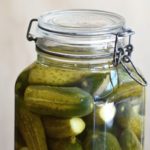Traditional Lacto-Fermented Pickles
Cucumbers have their own natural lactic bacterial culture, which makes them very easy to ferment. This traditional fermented pickle recipe will fill 2 mason jars. Feel free to scale it up if you want to make a larger batch. I usually do around 16 lbs of cucumbers each August. We really love fermented pickles!
- Prep Time: 20 minutes
- Total Time: 20 minutes
- Yield: 2 quart jars 1x
- Category: Pickles
- Method: Fermented
- Cuisine: Polish
- Diet: Gluten Free
Ingredients
Units
Scale
- 2 lbs pickling cucumbers
- 2 dill flowers or sprigs of dill weed
- 4 cloves of garlic
- 2 tsp pickling spices (optional, see notes)
- 2 Tbsp grated horseradish root (see notes for alternatives)
- 4 cups of water (chlorine-free)
- 1/4 cup of non-iodized salt (flaked pickling salt is best)
Instructions
- Wash the cucumbers and trim 1/4 inch (1/2 cm) off the blossom ends to help prevent the cucumber from going soft.
- Cut larger cucumbers, as required, to fit in your fermentation container.
- Divide the spices, dill, garlic, and horseradish root between the fermenting container (see the section above for options). The recipe is scaled for two 1-quart mason jars with 2 cloves of garlic, 1 sprig of dill, 1 tsp of spice, and 1 Tbsp of horseradish root in each jar. Pack cucumbers on top of the garlic and spices. Pack them as tightly as possible because the cucumbers will keep the spices from floating above the brine.
- Combine the water and salt to make a brine. Stir to fully dissolve the salt. Pour the brine over the cucumbers.
- Allow the pickles to ferment somewhere cool and dark for 2-7 weeks.
- If you are doing open-air fermenting, check the pickles every 2-3 days. Skim off the foam/scum and top up with non-chlorinated water as needed.
- Long-term storage of the pickles will depend on your fermentation container, so see the sections above for details. In brief, open-air ferments need to be stored in the fridge. Closed fermentation-specific containers can remain in a dark cupboard for several months.
Notes
- Fermented pickles will become soft and mushy over time. To prevent this, add a natural source of tannins to each mason jar. For example, 1 Tbsp of grated horseradish root, a grape leaf, or a pinch of black tea.
- Pickles need to ferment for at least 2 weeks, and usually much longer to develop their flavors. That also provides more time for your ferment to turn into a weird science experiment, so keep it clean and sanitize your jars before fermenting.
- If you can’t find pickling spice, feel free to replace it with 1 tsp of other spices. Black peppercorns, mustard seeds, fennel seeds, bay leaves, allspice berries, and coriander seeds are traditionally found in pickling spice.
- If you want probiotic pickles that has the tanginess of vinegar, then I recommend my Grandma’s Fermented Pickle Recipe. It’s very similar to this recipe, except that it uses vinegar to increase the acidity of the ferment.
Find it online: https://www.fermentingforfoodies.com/probiotic-pickles/
